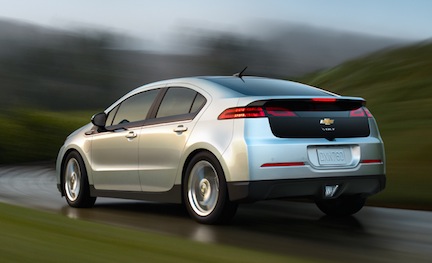
Automakers operate on a different calendar, in which the 2012 model year recently came to a close. As my colleague, Luke Tonachel, explains, this was the year of the green car, with record new fleet fuel efficiency, a 55 percent increase in hybrid sales, and more than a three-fold increase in plug-in electric car sales. The last of those three records might come as a surprise to some, given the prevalence of stories pronouncing the electric car dead on arrival. While it’s true that plug-in electric car sales still represent a very small fraction of total auto sales, model year 2012 saw about 38,000 Americans buying plug-in cars.* That’s a 228 percent increase over model year 2011.* Not bad for a new technology, introduced as the country recovers from the worst economic downturn since the Great Depression.
Critics often point out that plug-in electric car sales pale in comparison to incumbents such as the Ford F-series, Honda Accord, and Toyota Camry, but almost all vehicles fall short by that measure. Auto sales are lopsided; of the 265 vehicle models currently available, the top 20 comprise over 40 percent of all new sales. The Chevy Volt, often described by critics as a failure, falls right in the middle of the pack, outselling half the cars, trucks, and SUVs on the market. It may not be a smash hit, but it’s certainly not a flop as some would have you believe. In fact, the Volt is outselling many well-known models, including:
- Mazda: Miata, CX-7, Tribute, RX-8, 2, and 5
- Mercedes: S-Class, CL-Class, CLS-Class, SLK, SLS AMG, R-Class, G-Class, B-Class, and SL-Class
- Land Rover: LR2, LR4, and Range Rover
- Audi: A3, A5, A6, A7, A8, Q7, R8, and TT
- Lexus: GS, GX460, LX570, CT200h, HS250h, LFA, SC430, and LS
- BMW: Z4, X6, 1-Series, 6-Series, and 7-Series
- Nissan: 370Z, Quest, Cube, GT-R, Xterra, Titan, and Armada
- Porsche: Boxster, Panamera, Cayman, Cayenne, and 911
- Chevrolet: Caprice, HHR, Cobalt, and Corvette
You don’t hear pundits dismissing all those cars as failures, though they’re all selling less than the Volt. In fact, five of the models named above made Car and Driver’s vaunted 10 Best Cars list for 2012.
Dismissing modern plug-in electric cars less than two years after their introduction is also simply premature. The hybrid Toyota Prius is now the world’s third best selling vehicle, but that didn’t happen overnight. In 2000, the first calendar year the Toyota Prius and Honda Insight hybrids were made available in the US, combined sales were 9,350.* When the Chevy Volt and Nissan Leaf became the first widely available plug-in electric cars, combined annual sales were 17,840––twice that of the first year hybrid sales.* It should be noted that the Prius was not available for all of the year 2000. However, in their second year, the Prius and Insight combined for just over 20,000 sales. Second year sales of electric cars in contrast, led by the Volt, Leaf, and Plug-in Prius, are on pace to reach about 50,000 by year end––2.5 times the comparable year for the now ubiquitous hybrids.* That upward trend should continue over the next several years as automakers introduce up to 40 different new plug-in models.*
Nevertheless, it’s going to take some time for electric cars to reach a mass market, as is the case with any new technology. It took 45 years for electricity to reach 40 percent of our homes, and a full 64 years before the telephone did the same. Thankfully, technology adoption appears to be accelerating; mobile phones saturated the market in just 20 years, and tablets and smartphones are proceeding at an even quicker pace.
There’s reason to hope electric drive technology will continue this trend. Once folks get behind the wheel of an electric car and experience 100 percent torque from a standstill, a singularly quiet cabin, and the convenience of refueling at home, they’ll have a hard time going back to a car that relies on thousands of explosions of fossil fuel every minute. In many ways, vehicle electrification is the most important evolution in automotive technology since we ditched the steam engine.
In the long run, the advantages inherent in driving on electricity will attract drivers who are sick and tired of gas prices spiking every time there’s a violence in the middle east, a hurricane in the Gulf of Mexico, or a fire at a refinery in California. They’ll turn to electricity, a cleaner fuel made from a diverse supply of domestic resources, the price of which has been equivalent to buck-a-gallon gasoline for the last forty years, and is predicted to stay that way for the next three decades.
* Sales data and forecasts from Alan Baum & Associates.

Excellent news, Max. Thanks for sharing these stats.